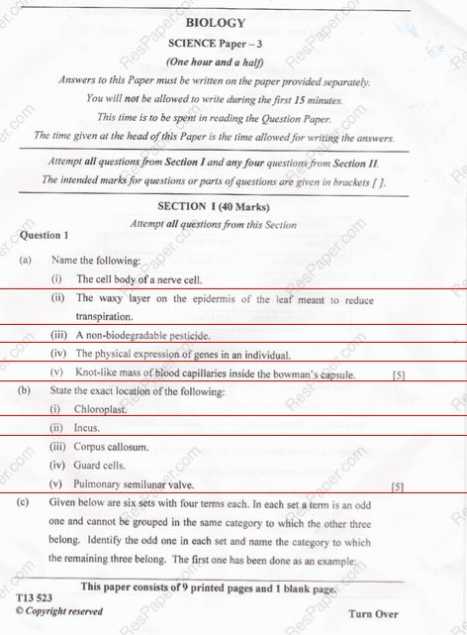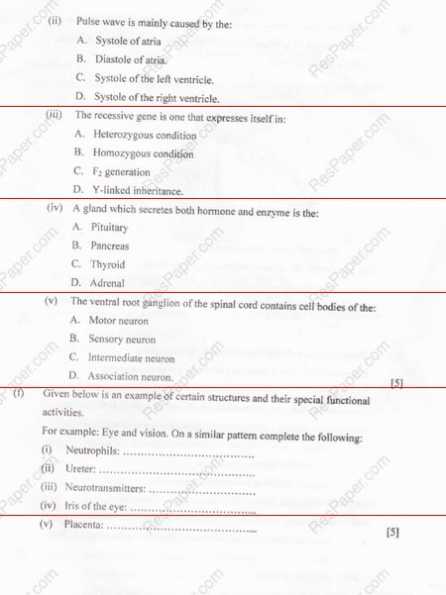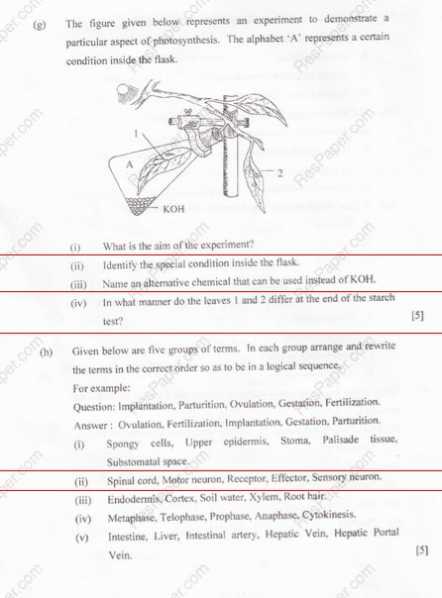|
#1
| |||
| |||
|
I am in class 10th. I want to get some previous year question papers of ICSE Board of Class 10th. So can you provide the question papers to me? ICSE or Indian Certificate of Secondary Education Board Biology syllabus for Class 10 on which the question paper is based is as follows: 1. Basic Biology (i) Cell Cycle and Cell Division: Cell cycle Interphase (G1, S, G2) and M.phase Cell Division: Mitosis and its stages. A basic understanding of Meiosis as a reduction division (stages not required). Significance and major differences between mitotic and meiotic division. (ii) Structure of chromosome: Basic structure of chromosome with elementary understanding of terms such as chromatin, chromatid, gene structure of DNA and centromere. (iii) Genetics: Mendel’s laws of inheritance and sex linked inheritance of diseases. Monohybrid cross, dihybrid cross. The following terms to be covered: gene, allele, heterozygous, homozygous, dominant, recessive, mutation, variation, phenotype, genotype. Sex determination in human beings. Sex linked inheritance of diseases to include haemophilia and colour blindness (only criss cross inheritance). 2. Plant Physiology (i) Absorption by roots, imbibition; diffusion and osmosis; osmotic pressure, root pressure; turgidity and flaccidity; plasmolysis and deplasmolysis,; the absorption of water and minerals, active and passive transport (in brief); the importance of root hair. Characteristics of roots, which make them suitable for absorbing water, should be discussed with the process of absorption. Structure of a single full-grown root hair should be explained. (ii) The rise of water up to the xylem; a general idea of Cohesive, Adhesive forces and transpirational pull); demonstrated by the use of dyes. Experiments to show the conduction of water through the xylem should be discussed. Mention of the causative forces must be made for better understanding but as per the syllabus. (iii) Transpiration, process and significance; experimental work includes the loss in weight of a potted plant or a leafy shoot in a test tube, the use of cobalt chloride paper and the effect of external conditions on the rate of water loss; Ganong’s potometer and its limitations should be stressed. Mechanism of stomatal transpiration must be explained so that concept of the process is clear. Adaptations in plants to reduce transpiration to be discussed. A brief idea of guttation and bleeding should be given. (iv) Photosynthesis: the nature of the process itself and the great importance of photosynthesis to life in general; experiments to show the necessity of light, carbon dioxide & chlorophyll and also the formation of starch and the output of oxygen; carbon cycle. The internal structure of chloroplast should be explained to give an idea of the site of light and dark reaction. Opening and closing of stomata should be explained. Teachers should stress upon the importance of a correct balanced chemical equation. The terms "photochemical" for light phase and "biosynthetic" for dark phase must be introduced. In the light reaction, activation of chlorophyll molecule followed by photolysis, release of O2, formation of ATP and NADPH should be taught. In the dark reaction (detailed equations are not required), only combination of hydrogen released by NADP with CO2 to form glucose to be discussed. Adaptations in a plant for photosynthesis and experiments with regard to the factors essential for the process should be discussed. 3. Human Anatomy and Physiology (i) Circulatory System: Main features; the structure and working of the heart, blood vessels, structure and functions of blood and circulation of blood (only names of the main blood vessels entering and leaving the heart, liver and kidney will be required). Composition of blood (Structure and functions of RBC, WBC and platelets). Brief idea of tissue fluid and lymph. Increase in efficiency of mammalian red blood cells due to absence of certain organelles should be explained with reasons. A brief idea of blood coagulation. Structure of vein, artery and capillary should be explained with the help of diagrams to bring out clearly the relationship between their structure and function. ABO blood group system, Rh factor; concept of double circulation; concept systole and diastole; blood pressure. Reference to portal system should be made. Working of the heart along with names of the main blood vessels entering and leaving the heart, the liver and the kidney must be taught. Examination of a blood smear under a microscope. (ii) Excretory System: Elementary treatment of the structure and function of the kidneys; the kidneys treated as comprising cortex and medulla and consisting of a branched system of tubules well supplied with blood vessels leading to the ureter (details of the courses of the tubules and their blood vessels not required). External and internal structure of the kidney; parts of the excretory system along with the blood vessels entering and leaving it should be taught with the help of charts or models. Students should be able to draw the diagrams with correct labelling and know the functions of various parts. A general idea of the structure of a kidney tubule nephron should be given. A brief idea of ultra filtration, selective reabsorption and tubular secretion in relation to the composition of blood plasma and urine formed. (iii) Nervous system: Structure of Neuron; central, autonomous and peripheral nervous system (in brief); brain and spinal cord; reflex action and how it differs from voluntary reflex. Sense organs – Eye and ear; Eye defects and corrective measures (myopia, hypermetropia, presbiopia, astigmatism and cataract). Various parts of the external structure of the brain and its parts (Medulla Oblongata, Cerebrum, Cerebellum, Thalamus, Hypothalamus) and their functions; reference should be made to the distribution of white and gray matter internally. Diagrammatic explanation of the reflex arc, showing the pathway from receptor to effector, differences between natural and acquired reflex should be taught. Structure and function of the Eye and Ear and their various parts. The external and V.S. of the eye must be taught with a brief idea of stereoscopic vision. The course of perception of sound in human ear. Role of ear in maintaining balance. (iv) Endocrine System: General study of the following glands: Adrenal, Pancreas, Thyroid and Pituitary. Difference in Endocrine and Exocrine glands. Correct location and shape of the gland in the human body should be discussed along with the hormones they secrete (Pancreas: insulin and glucagon to be taught; Thyroid: only thyroxin to be taught). Effects of hypo secretion and hyper secretion of hormones must be discussed. The term tropic hormones should be explained in the study of pituitary. Brief idea of feedback mechanism must be given. (v) The Reproductive System: Organs, fertilisation and a general outline of nutrition and respiration of the embryo. (Menstrual cycle: outline of menstrual cycle. Functions of organs and accessory glands must be discussed. An idea of secondary sexual characters, structure and functions of the various parts of the sperm and an egg. Fertilization, implantation, placenta, foetal membranes, gestation and parturition identical and fraternal twins to be explained briefly. (vi) Population: Problems posed by the increase in population in India; population control. Main reasons for the sharp rise in human population in India and in the world . The terms demography, population density, birth rate, death rate and growth rate of population should be explained. Methods of population control to be taught. 4. Physical Health and Hygiene (i) Aids to health: an understanding of the use and action of the following - vaccination; immunisation; antitoxin; serum; antiseptics; disinfectants; penicillin; sulphonamide drugs; First Aid. An idea of local defense system and their merits, active and passive immunity, difference between antiseptics and disinfectants to be discussed. Basic principles of first aid to be taught. (ii) Health organisations: Red Cross, WHO; common health problems in India. Major activities of Red Cross and WHO should be discussed. Common health problems in India. INTERNAL ASSESSMENT OF PRACTICAL WORK The practical work will be designed to test the ability of the candidates to make accurate observation from specimens of plants and animals. For this, the candidates should be familiar with the use of a hand lens of not less than x6 magnification. Candidates should be trained to make simple and accurate drawings and brief notes as a means of recording their observations. The practical examiners will assume that candidates would have carried out the practical work outlined below. PLANT LIFE (i) Observation of permanent slides of mitosis. Self-explanatory. (ii) Experiments indicating osmosis, diffusion and absorption. The teacher should give a demonstration and then the students should perform the experiments in order to have a better understanding of the processes. (iii) Physiological experiments on transpiration to be set up by the teacher and the pupils to identify the products, draw and label the apparatus. The teacher should set up the experiment stepwise so that the student gets a clear idea of the aim, apparatus, procedure and result of the experiment. For transpiration experiments the CoCl2 paper should be kept in a dessicator and its importance should be explained. Limitations for the use of Ganong’s potometer should be given. (iv) Experiments to show the necessity of light, carbon dioxide and chlorophyll essential for photosynthesis; release of O2 during photosynthesis. Candidates to write down their observations and draw and label the apparatus. Importance of destarching the plant before the experiment should be discussed. Diagrams should be drawn with the correct labelling. Pupils should be able to analyse the result. ANIMAL LIFE (i) Identification of the structure of the urinary system, heart (internal structure) and brain (external view) through models and charts (ii) The identification of different types of blood cells under a microscope. Different types of WBCs should be observed. Teacher should point out the differences between red blood cells and white blood cells. Ratio of red blood cells to white blood cells should be discussed. (iii) The structure of the Ear and an Eye (candidates will be required to identify each structure in the models of these organs). Models should be shown and students should draw correct labelled diagrams. (iv) Identification and location of selected endocrine glands (Adrenal, Pancreas, Thyroid and Pituitary glands) with the help of a model or chart. Correct labelled diagram to be drawn. (v) Compiling material for a First Aid box. Self-explanatory. Powered by TCPDF ICSE Exam Previous year question paper      respaper.com/icse/255/254/4827-pdf.html Last edited by Aakashd; June 29th, 2019 at 03:23 PM. |
|
#2
| ||||
| ||||
|
As you want to get question papers of ICSE Board Class 10th, so I want to tell you that firstly you have to mention that of which subject’s paper, you want to get. After mention, I must provide the question paper to you. I have following subject’s question paper: Mathematics Science Physics Chemistry Biology Environmental Education History and Civics Geography Computer Applications Economic Applications Commercial Applications English Language English Literature Hindi French German Sanskrit Punjabi Economics Commercial Studies Computer Science Technical Drawing Technical Drawing Applications Home Science Cookery Fashion Designing Art Still Life Art Nature Drawing / Painting Art Original Composition Art Applied Environmental Science Environmental Applications Physical Education Yoga Miscellaneous
__________________ Answered By StudyChaCha Member |
 |
| |